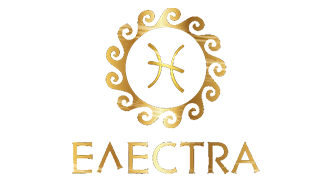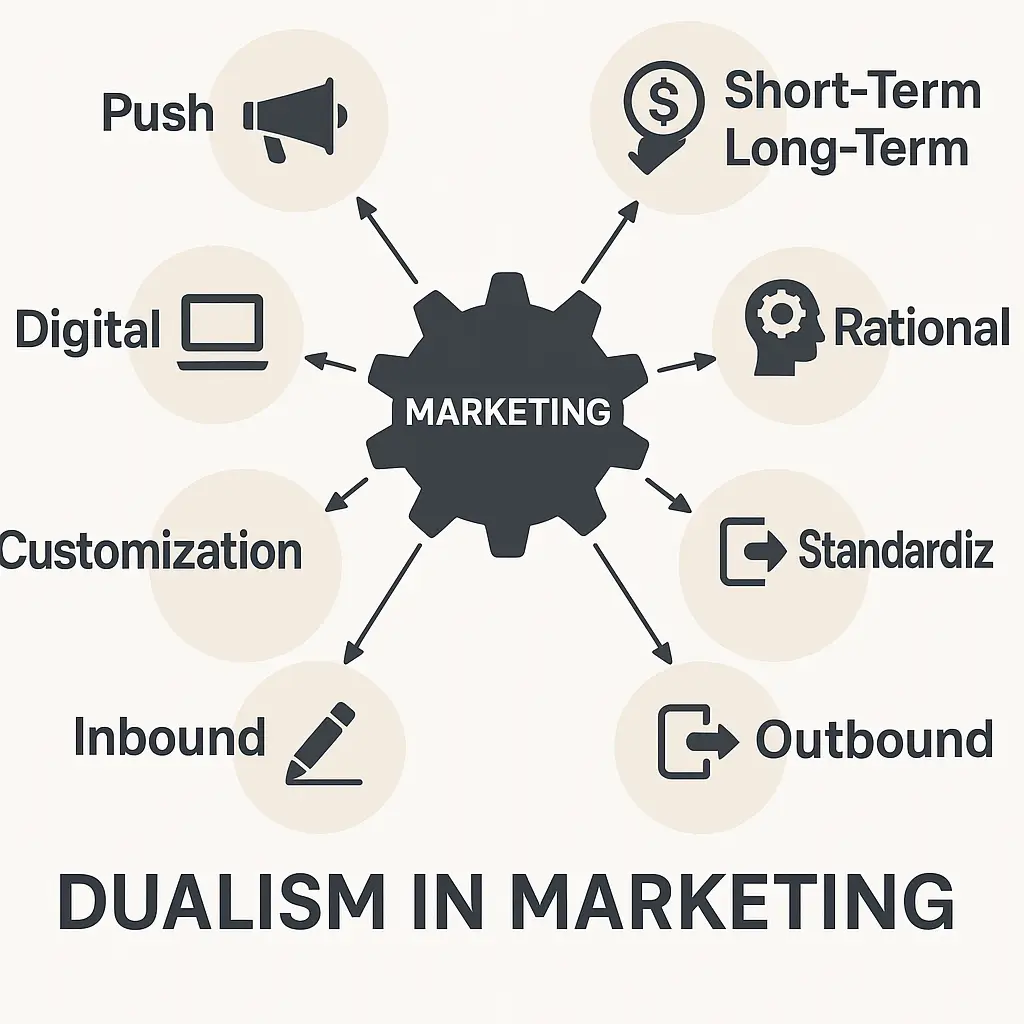Introduction
Marketing thrives on contrasts: immediate promotions vs. brand-building, data-driven logic vs. emotional storytelling, personalized experiences vs. scalable tactics. These dualities, when understood and balanced, can propel campaigns to success. This article delves into six fundamental dualisms in marketing, offering insights and actionable guidance on how to navigate and integrate them effectively.
1. Push vs. Pull Marketing
Definitions
- Push Marketing: Proactive outreach, where brands “push” messages to consumers via ads, direct mail, cold outreach, or outbound calls.
- Pull Marketing: Strategies that “pull” customers in by creating value and interest—content marketing, SEO, social engagement, and inbound approaches.
Balancing Act
- When to Push: For new product launches, limited-time offers, or audience segments unaware of your brand. Push tactics raise immediate awareness and drive quick actions.
- When to Pull: When nurturing long-term relationships, educating prospects, or building thought leadership. Pull strategies foster trust and sustained engagement.
Actionable Tips
- Coordinate campaigns: use push to amplify high-value content (e.g., promote a whitepaper via targeted ads).
- Measure and allocate budget based on ROI timelines: short-term push metrics (clicks, conversions) vs. long-term pull indicators (organic traffic growth, lead quality).
2. Short-Term vs. Long-Term Focus
Definitions
- Short-Term Marketing: Tactics aimed at immediate results—flash sales, promotions, limited offers, performance ads.
- Long-Term Marketing: Brand building, community engagement, content libraries, evergreen SEO, and relationship nurturing.
Balancing Act
- Importance of Short-Term: Generates quick revenue, addresses urgent business needs, and provides data on immediate market response.
- Importance of Long-Term: Builds brand equity, reduces dependence on paid channels, and fosters customer loyalty, leading to sustainable growth.
Actionable Tips
- Allocate budgets: earmark a percentage for brand-building (e.g., 20-30%) and the remainder for performance campaigns, adjusting based on business goals.
- Use insights from short-term campaigns (e.g., messaging that resonates) to inform long-term content strategy.
- Maintain a content calendar with evergreen and timely topics.
3. Digital vs. Traditional Channels
Definitions
- Digital Marketing: Online channels—social media, email, SEO, PPC, influencer, affiliate marketing, and programmatic ads.
- Traditional Marketing: Offline methods—print ads, TV/radio, billboards, direct mail, trade shows, and events.
Balancing Act
- Digital Strengths: Precise targeting, real-time analytics, scalability, personalization.
- Traditional Strengths: Broad reach, credibility in certain demographics, tactile experiences, and reinforcement of digital messages.
Actionable Tips
- Integrated campaigns: Use digital ads to drive awareness for an upcoming event; complement with print collateral at the event.
- Test and measure: Pilot small-scale traditional campaigns (local radio, direct mail) with trackable codes or URLs to gauge effectiveness.
- Audience insights: Understand where target segments consume media; younger audiences may favor digital, while older demographics might respond better to traditional channels.
4. Rational vs. Emotional Appeals
Definitions
- Rational Marketing: Focus on functional benefits: price, features, ROI, specifications, and logical arguments.
- Emotional Marketing: Appeals to feelings, aspirations, identity, and values—storytelling, brand narratives, and experiential messaging.
Balancing Act
- Rational Appeals: Effective in B2B, high-consideration purchases, and categories where specifications matter.
- Emotional Appeals: Drive differentiation, brand affinity, and viral potential; crucial for consumer brands, lifestyle products, and loyalty-building.
Actionable Tips
- Blend both in campaigns: e.g., an ad for software might highlight cost savings (rational) alongside team empowerment stories (emotional).
- Use data: A/B test messaging variations to see which mix resonates best with each segment.
- Map buyer journey: Early stages might need rational content (whitepapers, comparisons), later stages leverage emotional testimonials and case studies.
5. Customization vs. Standardization
Definitions
- Customization: Tailoring messages, products, and experiences to individual preferences or segments.
- Standardization: Using uniform messaging and product offerings for broad audiences, benefiting from economies of scale and brand consistency.
Balancing Act
- Customization Benefits: Higher relevance, improved engagement, and conversion rates; expected in service industries and digital platforms.
- Standardization Benefits: Cost efficiency, easier management, and consistent brand identity across markets.
Actionable Tips
- Segment-based customization: Develop modular content or product configurations for key segments rather than one-to-one personalization at scale initially.
- Leverage technology: Use personalization engines for email and website but maintain core standardized brand elements (logo, tone, mission).
- Test locale-specific tweaks: For global brands, standardize core messaging but customize cultural references or examples.
6. Inbound vs. Outbound Integration
Definitions
- Inbound Marketing: Attracting customers via valuable content, SEO, social engagement, and community building.
- Outbound Marketing: Reaching out via cold emails, display ads, sponsored content, and direct outreach.
Balancing Act
- Inbound Strengths: Builds trust, attracts qualified leads over time, cost-effective in the long run.
- Outbound Strengths: Immediate reach to specific audiences, helpful for new markets or when launching new offerings.
Actionable Tips
- Use inbound to nurture and educate prospects; trigger outbound follow-ups for high-intent leads identified through behavior (e.g., downloaded a demo).
- Synchronize messaging: Ensure consistency between content themes in inbound assets and copy in outbound campaigns.
- Measure combined funnel: Track journeys crossing inbound and outbound touchpoints to optimize attribution and budget allocation.
Integrating Dualisms into Your Strategy
- Audit Current Tactics: List your marketing activities and categorize them into the dualistic pairs above. Identify imbalances (e.g., overly short-term focus, or heavy push marketing without pull efforts).
- Set Balanced Objectives: Define KPIs for both sides—for instance, immediate conversion targets and brand awareness metrics.
- Develop a Mix Framework: Create a matrix mapping campaigns across dualities (e.g., a calendar plotting short-term promotions alongside long-term content production; digital ads supporting a traditional event).
- Leverage Data & Testing: Continuously A/B test messaging styles (rational vs. emotional), channel mixes (digital vs. traditional touches), and timing (short-term bursts vs. sustained efforts).
- Cross-Functional Collaboration: Align marketing with sales, product, and customer service to ensure dual strategies—like personalized experiences—are feasible and deliverable.
- Iterate & Evolve: Regularly review performance across dual dimensions, adjusting resource allocation, messaging, and tactics as market conditions and consumer behaviors shift.
Conclusion
Dualism in marketing isn’t about choosing one side over the other; it’s about harmonizing opposing forces to create a resilient, adaptable strategy. By understanding and balancing push vs. pull, short-term vs. long-term, digital vs. traditional, rational vs. emotional, customization vs. standardization, and inbound vs. outbound approaches, marketers can optimize impact, efficiency, and brand resonance. Embrace these dualities as complementary elements, and you’ll be equipped to navigate dynamic markets with agility and insight.

